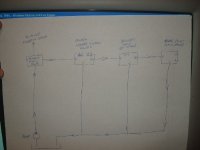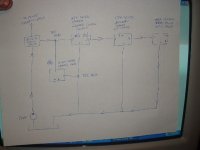Henro
Super Member
- Joined
- Jul 4, 2003
- Messages
- 5,004
- Location
- Few miles north of Pgh, PA
- Tractor
- Kubota B2910, BX2200, KX41-2V mini EX
Hi again, everyone, /forums/images/graemlins/smile.gif
I think I have digested and understand everyone's input so far...A couple more thoughts popped into my mind this morning…
BigAl added a “gentle hug” scenario to the picture, so I guess we now have “Hold me, Hug me, Squeeze Me” to consider. BigAl can adjust the amount of force his grapple applies, which sets the hug strength anywhere he likes between a gentle hold and a tight squeeze.
But when you think about it, once the control valve is centered, they all may become the same “Lock me in place” situation.
So it seems that if something is to be held under pressure, whatever is being held must be trying to spring back, after being stressed by the grapple due to the force the grapple applies when pushing against the item.
So a grapple that has more force available to its hydraulic cylinder, would have more ability to stress things, and would therefore be more likely “hold things” better.
When holding a rock, it could be that the bottom of the bucket is acting like a spring of sorts…
KennyV’s point of wanting sometimes to crush things illustrates an advantage of having more force available at the grapple than less. That makes a sense.
At this point, it seems to me that as long as things are designed so that at maximum system pressure one’s grapple does not self-destruct, having ample force exerted by the grapple is advantageous, and a strong push would be more desirable than a weak push.
It also seems that once cylinders are “locked” in position, regardless of how they are operated, if the control valves are equally good, the cylinders should hold position equally well.
What do you guys think? Is this reasonable?
Junkman,
I put that part about 100 psi under the red disclaimer because the background info that drove my question did not need to be given at all, but I thought it might be of interest.
A zero PSI example could have been used, such as a manually operated grapple that was moved by hand and latched in place.
The most definitive answer to your question was given by JerryG in that other thread where he said he had seen between 100 and 200 PSI system pressure in open center hydraulic systems at the lower end. I am paraphrasing what he said, but it is in his post. There were other comments in that thread by knowledgeable people pointing in that direction as well. There are other reasons, but those would be better left to another thread addressing this specific question. (Actually, Jerry might have posted that in a different thread…related to that original thread)
Thanks everyone! Keep those thoughts coming! /forums/images/graemlins/smile.gif
I think I have digested and understand everyone's input so far...A couple more thoughts popped into my mind this morning…
BigAl added a “gentle hug” scenario to the picture, so I guess we now have “Hold me, Hug me, Squeeze Me” to consider. BigAl can adjust the amount of force his grapple applies, which sets the hug strength anywhere he likes between a gentle hold and a tight squeeze.
But when you think about it, once the control valve is centered, they all may become the same “Lock me in place” situation.
So it seems that if something is to be held under pressure, whatever is being held must be trying to spring back, after being stressed by the grapple due to the force the grapple applies when pushing against the item.
So a grapple that has more force available to its hydraulic cylinder, would have more ability to stress things, and would therefore be more likely “hold things” better.
When holding a rock, it could be that the bottom of the bucket is acting like a spring of sorts…
KennyV’s point of wanting sometimes to crush things illustrates an advantage of having more force available at the grapple than less. That makes a sense.
At this point, it seems to me that as long as things are designed so that at maximum system pressure one’s grapple does not self-destruct, having ample force exerted by the grapple is advantageous, and a strong push would be more desirable than a weak push.
It also seems that once cylinders are “locked” in position, regardless of how they are operated, if the control valves are equally good, the cylinders should hold position equally well.
What do you guys think? Is this reasonable?
Junkman,
I put that part about 100 psi under the red disclaimer because the background info that drove my question did not need to be given at all, but I thought it might be of interest.
A zero PSI example could have been used, such as a manually operated grapple that was moved by hand and latched in place.
The most definitive answer to your question was given by JerryG in that other thread where he said he had seen between 100 and 200 PSI system pressure in open center hydraulic systems at the lower end. I am paraphrasing what he said, but it is in his post. There were other comments in that thread by knowledgeable people pointing in that direction as well. There are other reasons, but those would be better left to another thread addressing this specific question. (Actually, Jerry might have posted that in a different thread…related to that original thread)
Thanks everyone! Keep those thoughts coming! /forums/images/graemlins/smile.gif



